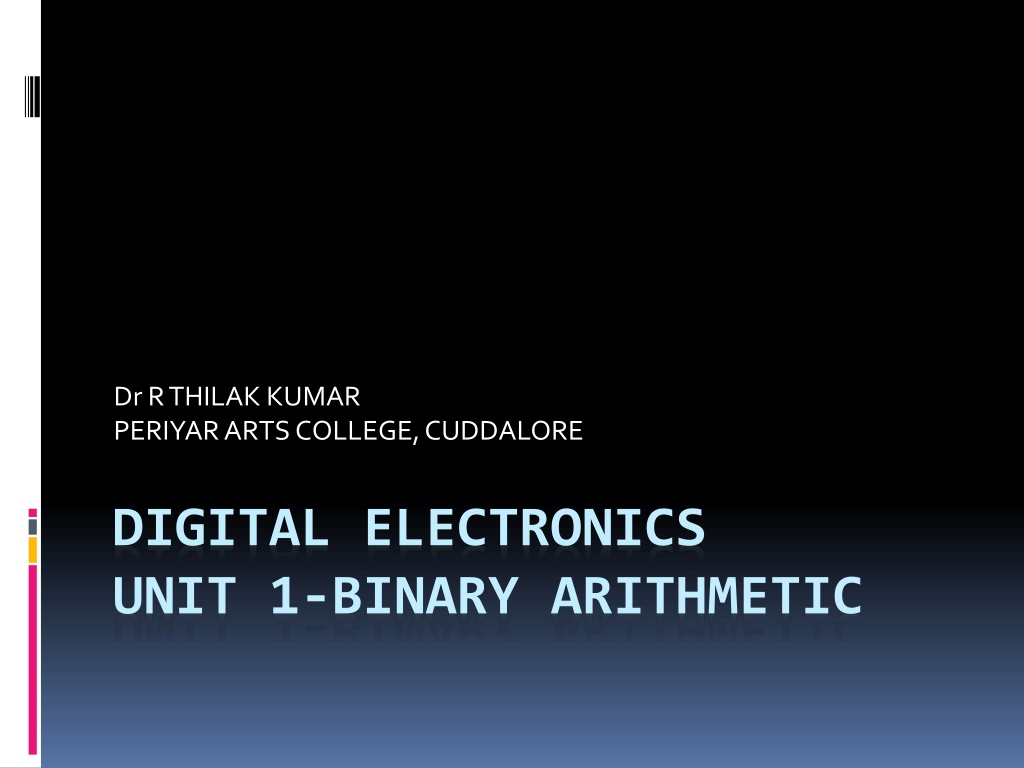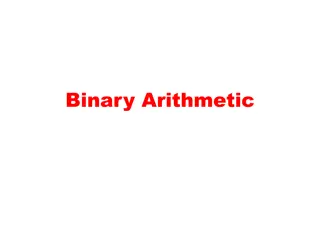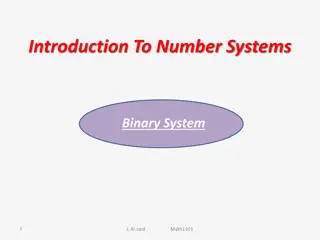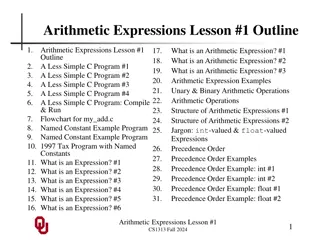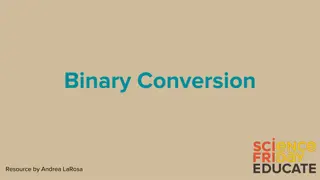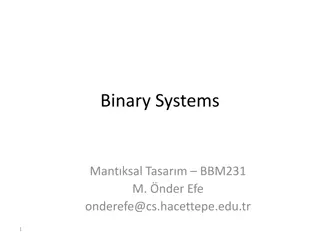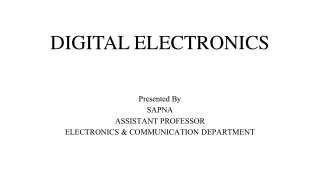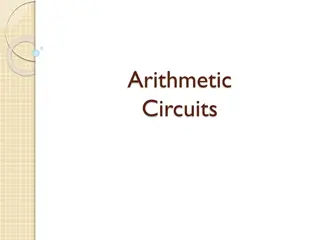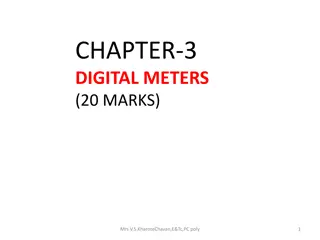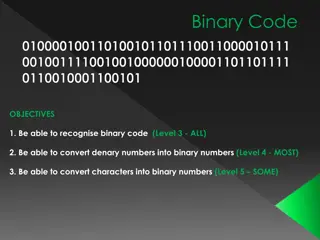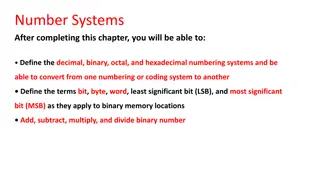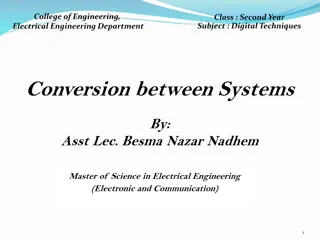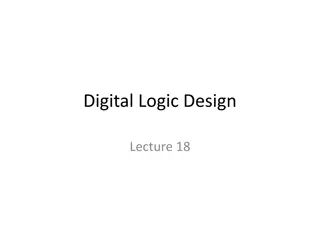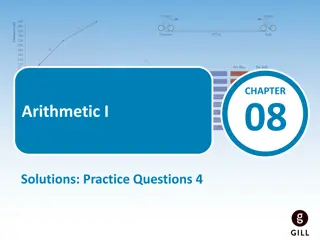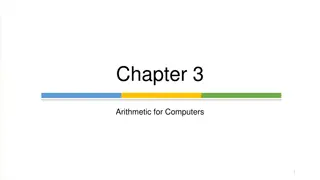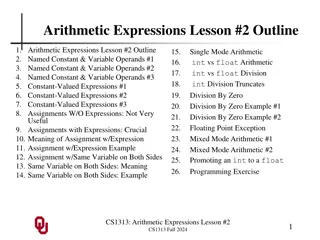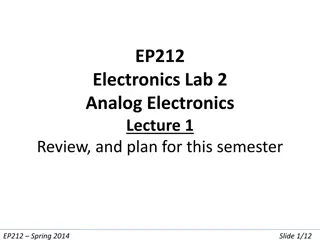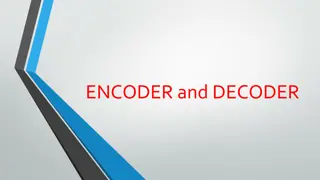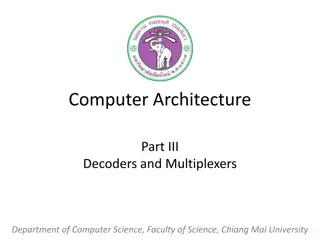Introduction to Binary Arithmetic for Digital Electronics
Binary arithmetic is fundamental in digital electronics, involving addition, subtraction, and multiplication of binary numbers. This guide explains the rules and examples of binary arithmetic operations, such as binary addition and subtraction, along with detailed steps and illustrations for better understanding.
Uploaded on Sep 21, 2024 | 0 Views
Download Presentation

Please find below an Image/Link to download the presentation.
The content on the website is provided AS IS for your information and personal use only. It may not be sold, licensed, or shared on other websites without obtaining consent from the author. Download presentation by click this link. If you encounter any issues during the download, it is possible that the publisher has removed the file from their server.
E N D
Presentation Transcript
DrR THILAK KUMAR PERIYAR ARTS COLLEGE, CUDDALORE DIGITAL ELECTRONICS UNIT 1-BINARY ARITHMETIC
BINARY ARITHMETIC Binary addition The addition of two binary numbers is very much similar to addition of two decimal numbers. The following rules are followed while adding two binary numbers. 0 +0 = 0 0 +1= 1 1+ 0= 1 1+ 1=10 :Read as 0with carry 1 1+ 1+1= 11: Read as 1with carry 1
Example-1 Add 5 and 6 The equivalent of 5 in binary = 101 The equivalent of 6 in binary = 110 1 (carry) 101 augend 110 addend 1 011
Example-2 Add 13 and 7 1 1 1 1 (carry) 1 1 0 1 1 1 1 1 0 1 0 0
Example-3 Add 94 and 125 94 = 5EH = 0101 1110 125 = 7DH= 0111 1101 1 1 1 1 0 1 0 1 1 1 1 0 0 1 1 1 1 1 0 1 1 1 0 1 1 0 1 1 D B
Binary Subtraction The subtraction of two binary numbers is similar to the subtraction of two decimal numbers. The following rules are used in subtracting twobinary numbers. 0 0 = 0 0 -1 = 1 1 (read as difference 1 with a borrow 1) 1 0 = 1 1 - 1 = 0
Example-1 Subtract 5 from 7 1 1 1 (minuend) 1 0 1 (subtrahend) 0 1 0
Example-2 Subtract 3 from 13 0 1 1 1 0 1 0 1 1 1 0 1 0
Example-3 Subtract 14 from 17 1 110 1 0 0 0 1 1 1 1 0 0 0 1 1
11 10 1 (5) 1 1 1 (7) 1 1 0 0 (12)
Binary Multiplication The following rules are used to multiplay two binary numbers 0 0 = 0 0 1 = 0 1 0 = 0 1 1 = 1 It is similar to the decimal multiplication
Example Multiply 13 and 11 Binary equivalent of 13 = 1 1 0 1 Binary equivalent of 11 = 1 0 1 1 1 1 0 1 1 0 1 1 ---------- 1 1 0 1 1 1 0 1 1 0 0 0 1 1 0 1 ------------------- 1 0 0 0 1 1 1 1 -------------------- (8F)H
Binary division Binary division has only two rules Divide 10 by 4 2 2.5 4 10 8 8 ------ 2 20 ------- 4 10 0 1 = 0 1 1 = 1 ------- 20 ------ 0 -------
10.1 100 10 10 100 0 ------- 100 100 --------- 0 ----------
1s complement and 2s complement Complements are used in digital computers in order to simply the subtraction operation and for the logical manipulations. For the Binary number (base-2) system, there are two types of complements: 1 s complement and 2 s complement. 1 s Complement of a Binary Number To get 1 s complement of a binary number, simply invert the given number. 2 s Complement of a Binary Number To get 2 s complement of a binary number, simply invert the given number and add 1 to the least significant bit (LSB) of given result.
1s complement Binary number 1 s Complement 1011 0100 110001 001110 100100 011011 11001110 00110001 10101101 01010010 1111111 0000000
2s complement 1 complement of 1010 = 0101 2 complemtn of 1010 = 0101 1 ------ 0 1 1 0
2s complement Binary number 1 s complement 2 s complement 1011 0100 0101 110001 001110 001111 100100 011011 011100 11001110 00110001 00110010 10101101 01010010 01010011 1111111 0000000 0000001
Subtraction using complements
1 0 0 0 1 1 0 0 0 1 1 1 1 0 0 1 1 1 0 ----------------- + 1 0 0 0 1 10 0 0 1 0 1 -------------- 0 0 0 1 1
2 complement subtraction Subtract 18 from 12 12 18 --- - 6 --- 1 1 0 0 0 1 1 0 0 1 0 0 1 0 1 0 0 1 0 1 s complement method 0 1 1 0 0 0 1 1 0 1 1 1 0 0 1 No carry is produced. It indicates that the result is negative. The 1 s complement is 0 0 1 1 0 = 6
